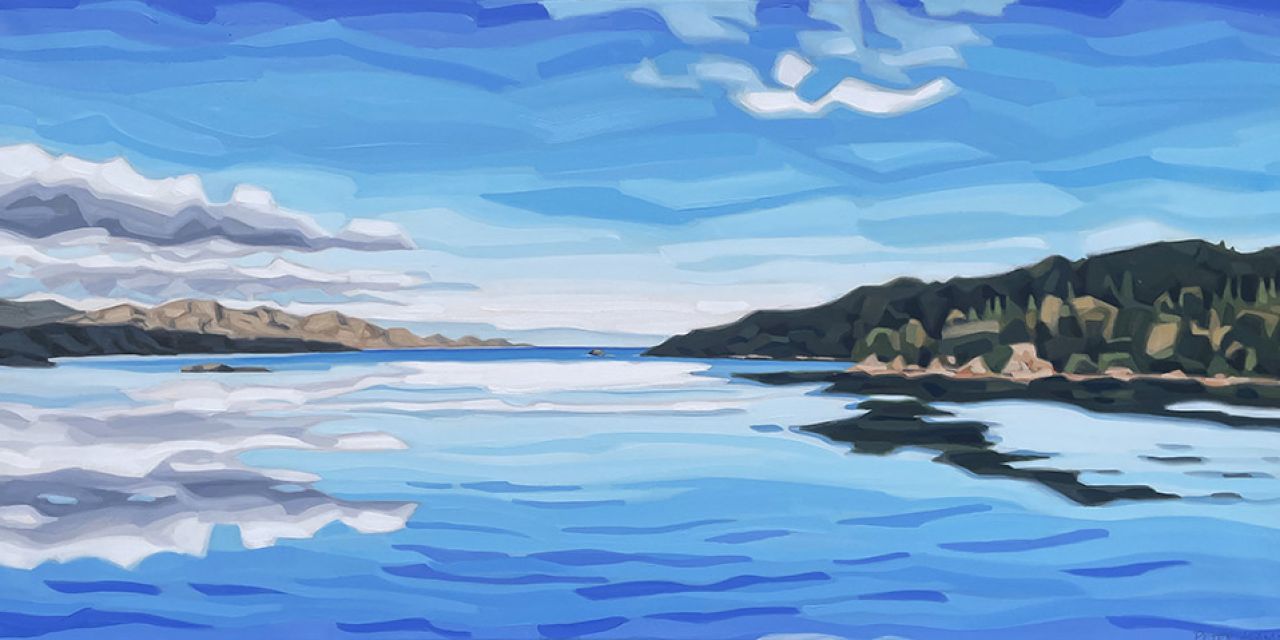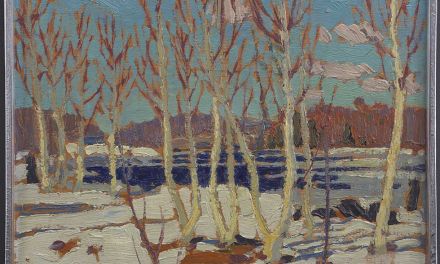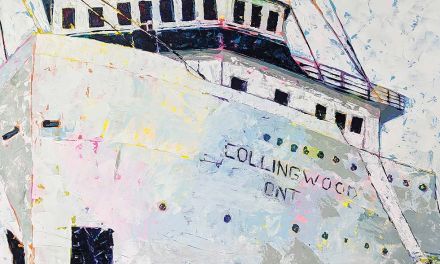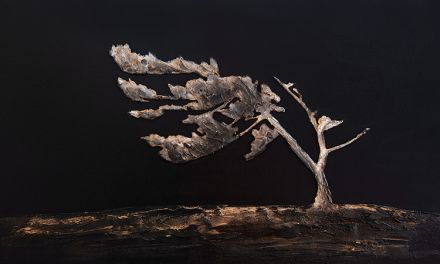The View From Dorlin #2, 24″ x 48″, oil on canvas.
Emotion, Energy and Exploration
by Deena Dolan
Juxtaposing realism with abstraction, Peter Adams’s compositions capture the emotional essence of place while highlighting the complexity of human immersion in nature.
To simply state that Peter Adams is an award-winning artist doesn’t provide an accurate impression—his list of accomplishments is staggering. Just to mention a few… he has been the top name in numerous “Best of Show” and “Artists’ Choice” awards along with grants from the Ontario Arts Council. He was shortlisted for the 2017 Kingston Prize—Canada’s national portrait competition. He was a finalist in the Salt Spring National Art Prize in 2015 and in 2023, and he was invited to participate in Brazil’s Labverde Arts Immersion Program in 2017.
When I chatted with Peter for this feature, he was working on a series of paintings that resulted from a trip to Norway in October 2023 — ‘The Arctic Circle’: an annual expeditionary residency program. Established in 2009, this project brings together international artists of all disciplines, scientists, architects, and educators who collectively explore the High-Arctic. Participants lived and worked for two weeks aboard a specially outfitted Arctic-class expedition ship, while sailing the waters of the international territory of Svalbard, an Arctic Archipelago just 10 degrees latitude from the North Pole. They had the opportunity to pursue their personal projects on board and ashore, while exploring collaborations with the expedition’s fellow members.

Photo by Gary McGuffin.

The late fall timeframe presented an otherworldly landscape, perspective, and relationship; void of lights, boats, or people. Peter’s renditions of these serene settings present a reassuring sense of calm while, at the same time, capturing a feeling of constant movement, particularly in the vastness of the skies. One is left with an impression of absolute quiet influenced by ongoing change. “Over the years, my work has evolved from high realism to painting in a more expressive style, interpreting the landscape as a gestural dance across the canvas,” says Peter. This new series will be featured at Gallery Lagom in Creemore during the month of October. It will be a delightful opportunity to view these ethereal new works in person.
While his paintings explode with emotion and energy, Adams takes the viewer into and beyond the canvas, to explore and wander about, to ask questions, and to learn. Describing himself as constantly curious, he invites a dialogue that deals with the complex relationship we humans have with nature. “I believe any chance to reaffirm our connection to nature is essential to better understanding ourselves.” Peter finds himself constantly questioning the human relationship with nature, and how it’s changing over time.
Born in Glasgow, Scotland, Peter moved to Toronto as a toddler with his mother and brother. He credits his mother with exposing him to the wonders of art and nature as a child. “I also had an uncle who was an accomplished musician who dabbled in painting and sculpture, then later taught himself how to rebuild pianos and antique clocks. He was an eccentric guy, but definitely influenced my desire to be a creator of some sort.”
Peter studied Fine Arts at York University for one year, but then, interestingly, turned to the world of film by earning an Honours Bachelor of Arts degree in Film Studies at Queen’s. The industry held his interest for a while but, describing himself as an idealist, he became somewhat disillusioned and subsequently gathered his oils and brushes again and refocused his artistic attentions towards the canvas. He hasn’t looked back.

Interior Reflection, 30″ x 30″, oil on canvas.

Northern Passage, 36″ x 36″, oil on canvas.
An opportunity in the late ’90s to relocate from downtown Toronto to a rural setting outside of Creemore turned out to be absolutely life-altering. Home became a rustically modest cabin in the woods, with no phone or internet where everyday focus shifted to the touched as well as the untouched beauty of nature and the simplicity of the rugged and often pastoral landscape around him. Creemore holds a special place for Peter. During his years there, he immersed himself in the budding artistic community as his career began to blossom with increased sales and commissions. He found himself documenting changes in his surroundings, and always questioning, “What is landscape?” In 2004, several Creemore area artists, including Peter, joined with several other community volunteers to cofound Mad and Noisy Gallery, a non-profit gallery that also offered workshops, concerts, and all kinds of outreach for the ever-expanding arts scene in Creemore. He credits John Wiggins, founder of Creemore Springs Brewery, with having a vision back in the 1980s for what a special place Creemore could become. Wiggins was an artist in his own right and successfully encouraged other creative people to relocate there, establishing it as a credible arts community.
As a committed, full-time artist, Peter moved to Collingwood in 2018 where he continues to be aggressively adventuresome in his work. ‘Same old, same old’ doesn’t exist. He constantly takes risks and explores new avenues—mixing media, for example, doing the unexpected, and boldly varying his subject matter. “I’m fascinated by how we connect with and alter landscape and try to co-exist with nature,” says Peter. At times, his pieces become more political and layered, as in his series called Earth Scars/Altered Landscapes, which are a contemplation of the altered landscape with a focus on open-pit mining around the world and the sustainability of resource extraction. “Aware of the unprecedented demand for limestone aggregate in Ontario, I began researching the largest holes in the earth. My research was first focused on The Big Hole, a diamond mine in Kimberley, South Africa. Mining ceased in 1914, though it is still believed to be the largest hole in the earth that was entirely excavated by hand. I have since gone on to research the mines of Russia, South America, and Canada. I see the paintings in this series as portraits of a landscape transformed by humans and as reflecting pools for a discourse on the sustainability of resource extraction, asking the viewer to ponder which are the vital resources and at what cost they are extracted.”

American Camp Revisited, 30″ x 40″, oil on canvas.
Peter respects a diverse variety of other artists’ works: American abstract painter Mark Rothko, American modernist painter and draftswoman Georgia O’Keefe, and Canadian painter and printmaker Alex Colville—works that are multi-faceted. However, as an impressionistic landscape artist himself, Adams never attempts to emulate another artist. “I don’t consciously think about my diverse influences. My style has evolved naturally out of these influences, as well as out of life experiences and experimentation.”
“I am always discovering new parallels between painting and all the other arts. I approach stages of a painting the way many writers approach their craft: idea, then outline, then first pass, second pass, etc., until they are satisfied with the result.”
To that end, Peter always has a new project on the go. “When I work on things, I get a bit restless. I get stuck sometimes and need to step back to get a fresh perspective on what I’m doing. Sometimes I will start a new piece just to have a break from something I’m working on. It’s always very satisfying to start something new and to ponder the potential of a blank canvas.”
Peter took part in the Labverde Arts Immersion Program in Brazil, a trans-disciplinary platform based in the Brazilian Amazon. Its main focus is the development of environment related artistic languages, working in the production and democratization of knowledge through residencies, lectures, exhibitions, festivals, workshops, and publications. Created by a women’s collective in partnership with the National Institute of Amazonian Research (INPA), the platform brings together artists, indigenous people, scientists, and other knowledge agents with a common goal: to recognize and narrate nature, in an attempt to create new ways of existence and interaction with the environment; and to co-imagine new approaches to current ecosystems. While there, Adams explored the human relationship with landscape through small paintings in what he calls “specimens” and “souvenir” boxes.

View from Four Way Lodge, 30″ x 48″, oil on canvas.

Ascending Glance, 30″ x 40″, oil on canvas.

Swift Advance, 24″ x 36″, oil on canvas.

Detachment at Kerker’s Cove, 30″ x 40″, oil on canvas.
Between August 2022 and November 2023, Adams visited the Rose Island Nature Reserve as part of The Rose Island Specimen Project—a series of paintings in small iPad boxes, seeking artistic specimens that shed light on the unique flora, fauna, and geology there. “I think these new works create an interesting dialogue about how we value the land and how we relate to unaltered landscapes,” says Adams. A glacial deposit, making the island ecology vastly different from the more familiar Georgian Bay landscape so often celebrated in local art, caps the 286-acre Georgian Bay Land Trust site in the Parry Sound area. Peter elaborates, “Accessible only by boat, Rose Island is not rocky and windswept; it is instead a sandy loam-covered island featuring old-growth diverse woodland. Additionally, the reserve is an island-within-an-island of sorts, a largely untouched ecosystem at the centre of the island, which is surrounded on all sides by shoreline cottages.” It is Peter’s hope that his Specimen Series will provide audiences with a compelling reason for discourse on the importance of conservation and on the need for immersion in nature in this era of social isolation and technological dependency.”
“When I’ve been working on a lot of commissions, I feel like getting back to something with more meaning and depth,” he explains. “I try to balance the two. In a way, the Rose Island project is a balance. I want to make beautiful paintings but also hope to get people thinking about conservation, how we relate to nature, and what roles organizations like the Georgian Bay Land Trust play in society. I think it’s good to be thinking about this now.”
An accomplished portrait painter, Peter’s website has a section titled, The Human Condition, which showcases several works he’s produced over the years—somewhat raw, but real people in equally raw, but real settings. Weight Bearing Limbs has been accepted as a finalist in the Scottish Portrait Awards. The Scottish Arts Trust will be exhibiting all finalists in Edinburgh this coming fall.
“Painting for me is a combination of observation, reflection, editing, designing, and then performance. I paint in a similar way to how a film composer composes a film’s score… emotionally responding to, and enhancing the visuals and story they are given. Paintings that really excite me though, they look more like a jazz performance. Perhaps that is what I’m working towards.” E
For information on upcoming shows, please visit: peteradamsart.com

Bend Resonance #2, 30″ x 60″, oil on canvas.








